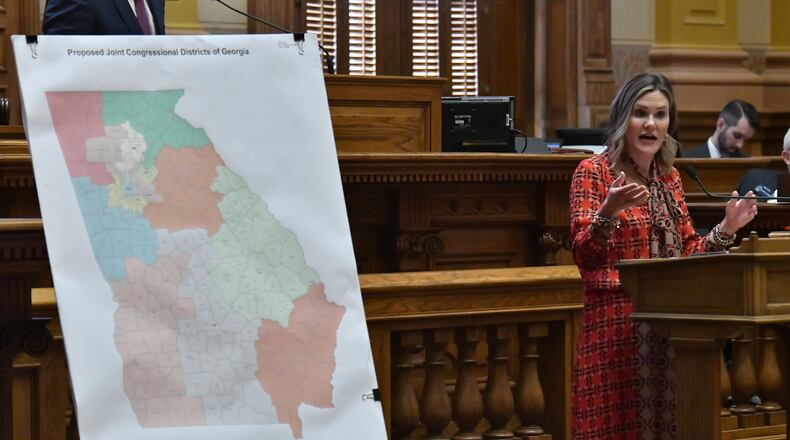The completion of redistricting sets up the next decade of Georgia elections with maps that give Republicans an advantage in the U.S. House of Representatives and the General Assembly.
But Georgia remains a rapidly changing political battleground where Democrats have made gains in recent elections, including winning last year’s races for president and the U.S. Senate.
The majority-Republican General Assembly concluded a 15-day special redistricting session with a final vote Monday, sending maps to Gov. Brian Kemp for his signature.
Republicans poised to gain a seat in Congress
Georgia’s new congressional map creates a 9-5 Republican advantage over Democrats heading into next year’s elections. Republicans currently hold an 8-6 majority in Georgia’s congressional delegation after Democrats flipped two suburban Atlanta seats in 2018 and 2020.
Republicans plan to reverse some of the Democrats’ gains by changing the composition of the 6th Congressional District currently held by Democratic U.S. Rep. Lucy McBath, mapping it to include many more conservative voters.
The new 6th District reaches north from Cobb and Fulton counties into heavily Republican areas in Dawson and Forsyth counties.
After McBath won 55% of the vote in last year’s election, the new 6th District favors Republicans by 15 percentage points, according to estimates by The Atlanta Journal-Constitution based on voting patterns. McBath announced Monday that she plans to run for Congress next year in the 7th Congressional District in Gwinnett County, which legislators made more Democratic.
Credit: Isaac Sabetai
Credit: Isaac Sabetai
The impact of gerrymandering
The Republicans’ majority in the General Assembly gave them the votes they needed to pass maps that confer a political advantage in a state that’s nearly evenly split between the two political parties. Kemp a Republican, won by nearly 55,000 votes in 2018, and Democrat Joe Biden won Georgia by less than 12,000 votes last year.
GOP legislators were able to draw district boundaries that include enough Republican voters to help them win elections while mapping Democratic-leaning neighborhoods into areas where their votes are unlikely to swing elections.
The U.S. Supreme Court has upheld redistricting for partisan purposes, and Democrats have also used redistricting for their benefit in states where they hold majorities.
As a result, statewide elections in Georgia will likely remain close contests, but Republicans have an edge in Congress, the state House and the state Senate.
Noncompetitive elections
None of Georgia’s new congressional districts are projected to be competitive in next year’s elections.
While the district represented by McBath will become solidly Republican, the Gwinnett County-based district represented by Democratic U.S. Rep. Carolyn Bourdeaux was reshaped into a more solidly liberal area. Bourdeaux won with 51% of the vote last year, but the redrawn 7th District would lean 22 percentage points toward Democrats.
The most competitive district is expected be in southwest Georgia, where Democratic U.S. Rep. Sanford Bishop is projected to have a 10 percentage point advantage, according to the AJC’s estimates of voting patterns.
GOP dominance in the General Assembly
Besides a new congressional map, the Republican-controlled General Assembly also approved redistricting plans for the state House and Senate that safeguard GOP majorities.
However, the maps make room for Democrats to pick up a few seats because of population growth in Democratic-leaning metro areas, along with population declines in more rural areas that tend to vote for Republicans. Each district is required to have a roughly equal number of residents.
The state Senate map redraws a Johns Creek district held by Democratic state Sen. Michelle Au, making it lean Republican. But the map also creates new Democratic-leaning seats, one in Gwinnett and another near Roswell and Sandy Springs in Fulton County. As a result, the Senate will be left with 33 districts that tend to vote for Republicans and 23 that lean toward Democrats.
The new state House map also benefits Republicans, with 98 districts favoring Republicans and 82 tilted toward Democrats. Republicans currently hold a 103-77 advantage in the House and a 34-22 lead in the Senate.
A changing Georgia
Redistricting allows the majority party to design new districts, but the impact of those maps tends to fade as time passes.
The immediate consequence of redistricting will be in next year’s elections, when the new maps most accurately reflect the political leanings of each district. Population changes and shifting political attitudes could erode the effectiveness of political boundaries that favor Republican candidates.
A similar trend occurred the last time legislators redistricted Georgia in 2011. Republicans won more seats in the General Assembly the following year, but Democrats have made inroads in elections since then.
Georgia’s population increased by 1 million residents over the past decade, with people of color accounting for all that growth as the number of white residents fell. New residents and racial minorities both tend to vote for Democrats.
If Georgia’s demographic trends continue, the state is likely to continue adding more Democratic voters in the coming years.
About the Author
Keep Reading
The Latest
Featured





